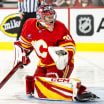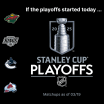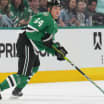In NHL.com's Q&A feature called "Sitting Down with …" we talk to key figures in the game, gaining insight into their lives on and off the ice. In this edition, we feature retired NHL forward Andrew Ladd, his 1616 mental health program geared toward youth hockey players launching Sunday and life after his playing days.
Ladd talks 1616 initiative, foundation in NHL.com Q&A
2-time Stanley Cup winner focused on helping youth hockey players learn how to handle adversity with 'buffalo mentality'
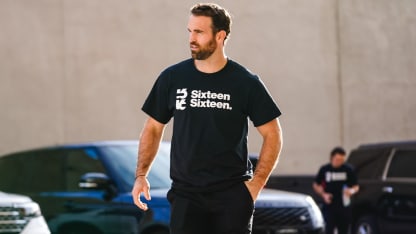
© Ladd Foundation
By
Jon Lane @jonlanenhl.bsky.social
NHL.com Staff Writer
It's called 1616 and the primary initiative of Ladd Foundation beginning Sunday will support mental well-being for youth hockey players ages 10-12, their coaches and caregivers.
The name for the program comes from Andrew Ladd's playing number throughout an NHL career that lasted, yes, 16 seasons, and the story of a voyage through the Lake Huron region by French explorer Samuel de Champlain during the winter of 1616.
De Champlain was one of the first to explore Canada and what today is Northeastern Ontario. He was shown a drawing of the North American bison by members of the Nipissing First Nation, discovered their skins and is credited with being the first to use "buffalo" to describe the species. There also was something very distinctive about the buffalo. Instead of retreating when a storm hit, the animals plowed through it quickly as a group.
It's the genesis of the buffalo mindset and Ladd's inspiration behind 1616.
"It made sense in terms of the mentality that we're trying to teach kids, that you're going to have tough moments and challenges in your life," Ladd said. "We want to teach them the buffalo mindset, which is pushing into those challenges because those will help you grow, and you'll get stronger because of it."
Registration is open for 1616 , a free, 10-week season running until Dec. 31 featuring stories from NHL players and alumni and supported by the NHL/NHLPA Industry Growth Fund. In its 10th anniversary season, the IGF has invested more than $14 million in numerous community impact programs and initiatives in the United States and Canada, encouraging at least 40,000 young boys and girls to try hockey for the first time.
"The goal of the NHL and NHLPA's Industry Growth Fund is to develop healthy, vibrant, well-rounded individuals through hockey," NHL senior vice president of community development and industry growth Robert Knesaurek said. "When we learned about Andrew Ladd's 1616 initiative, we recognized it as an invaluable opportunity to build resilience and character in young hockey players, their parents, and coaches. ... By providing free tools to navigate adversity, 1616 aligns perfectly with our commitment to fostering a safe and supportive environment."
Ladd and his wife, Brandy, live in Kelowna, British Columbia, with their three children: Locklan, 11, Andi, 10, and Walker, 8. The two-time Stanley Cup champion (Carolina Hurricanes, 2006; Chicago Blackhawks, 2010) and captain of the Atlanta Thrashers/Winnipeg Jets from 2010-16 tore the ACL in his left knee while playing for the New York Islanders against the Arizona Coyotes on March 24, 2019. He recovered but the Islanders placed him on waivers Nov. 19, 2019, and loaned him to Bridgeport of the American Hockey League the next day.
Instead of fleeing, Ladd kept going. He returned to play four games for the Islanders in 2019-20, then after playing one game in 2020-21, with Bridgeport, he played 51 games with the Coyotes after being traded to Arizona on July 17, 2021. A failed physical following knee surgery sidelined Ladd the next season and he retired Sept. 10, 2023. He finished with 550 points (256 goals, 294 assists) in 1,001 NHL games and became the 370th player all time to reach 1,000 games April 20, 2022.
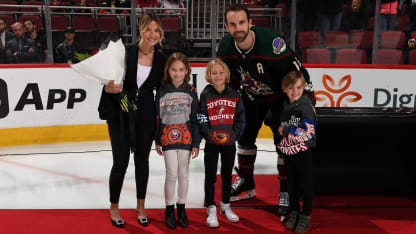
© Norm Hall/NHLI via Getty Images
Andrew and Brandy founded Ladd Foundation in 2020. His time working with Novus Global performance coach Dan Leffelaar during recovery from his knee injury was incentive behind what he wanted to do next.
"There's a lot of emphasis on the physical side of the game and not a whole lot on the mental side of the game, so we really want to treat this like taking your brain to the gym and emphasizing that portion," Ladd said. "We think we've covered a really organic way to teach kids through the power of stories."
NHL.com spoke with the 38-year-old about 1616, the turning point in his life, the Blackhawks, Islanders and the Utah Hockey Club that's in its inaugural season after relocating from Arizona. The launch of 1616 three days after World Mental Health Day is coincidental, but aligns with what's based on more than 30 years of research and positive youth development being put into action.
The 1616 program is built around the 4Cs: Competence, Connection, Character and Confidence. How do you break down the 4Cs?
"The research says that, essentially, if you can affect those four Cs where you're teaching the kids those four different concepts, or different Cs, you create the ideal environment for them to thrive in sport and life. There's a nonprofit in Calgary called Impact Society and they teach kids in the classroom through story. You find kids will remember a really impactful story for a long, long time, or humans in general do, so that really resonated with me. And it was like, OK, how do we take a lot of the stories of current or former athletes that have had a lot of success in our game and use their lived experiences to teach kids."
Is it the 4Cs or are there other aspects to 1616 that make it unique?
"There is no other program like this in sport. We've specifically designed it to not be a big lift for everyone involved. It's like a small drip over the course of the season, so something to help you lean on even as a coach, just different concepts to talk about."
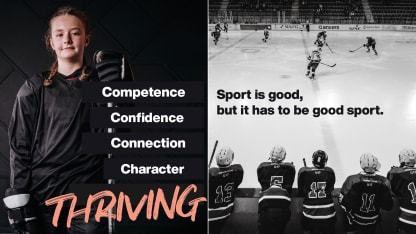
© Ladd Foundation
What did you learn from adversity and how have you used it to help kids rise to challenges?
"It's easy to lead when things are going well. It's hard to lead when things are not going very well. We have a choice of how we want to show up. I think that was a great training ground for me during the end of my tenure in New York until I got back to playing in Arizona. There were a lot of things, a lot of adversity, and I get to choose how I want to show up at the rink. I get to choose the impact that I want to have on the people around me. It was the next level of leadership and growth in my life in terms of, I'm in this situation that I don't want to be in, how do I maximize that? How do I make the most out of it? And 1616 really is the result of spending that time, being intentional, having purpose and trying to make the most of it."
Did you want to end your playing career on your terms?
"I think that was part of it. I was 50 games away from 1,000 and had that in my head. I wasn't done with it yet and I needed the idea of getting back to the NHL. I'm sure there were a lot of people that had doubts that I would ever get back to the NHL and be able to play NHL games again and play 1,000 games. I would include myself in some of that. It was part of that battle. There's moments where you want to give up and you need people around you to help pull you through."
There was a conversation with Brandy suggesting you talk to someone. How much of a turning point was that?
"It takes courage to tell someone that, so I'm grateful for her courage and her care for me. It was a weird moment because I knew something wasn't right. I was floating through life and was a little bit numb to everything. Luckily I was traveling from Long Island to Bridgeport with (then-Islanders defenseman) Thomas Hickey, who at that time was working with Dan (Leffelaar). On those car rides, it was me opening up about wanting to find someone to talk to and then it was him saying this is the person I use. In one conversation with Dan, it was, OK, this person can help me. This is the space for me to hash out a lot of this stuff to help me. From there it was on me to leverage that space as much as I could."
Was that when the seeds were planted for 1616?
"We wanted to find something proactive in the mental health space, the experience of going through and working on that in my own life, and seeing how the situation, the challenges that were presented in front of me, and how I was treating that as a way to grow. I was playing with a lot of the concepts, what we have for kids in the program right now. It gave me more insight into, here's the value of this and how I want to try to connect with kids through a lot of this stuff that I was going through."
How's life since retirement?
"After I finished, the transition was interesting. It was helpful to have a performance coach as I was transitioning out of the game. I remember him asking me, what do you want to do now? I was like, no one's asked me that question since I was probably 10. People were telling me what to do the last 30 years, so I had to really sit with that and 1616 was part of that continuing journey, helping build that program and be a visionary for where we want that to go. I loved the impact my performance coach had on me. I wanted to learn how to have those skills, so I went through the training program to be able to do what they do. Through that process, I was like, I want to do this. I want to continue to help athletes and have the impact that I had going through that same thing."
The Islanders are running it back with mostly the same group. They added forwards Anthony Duclair and Maxim Tsyplakov and are hoping goalie Ilya Sorokin can revert to form. How far do you think coach Patrick Roy can take them?
"I had a front-row seat for watching Sorokin come in during my time there. He is a special goalie. If he gets back to form, I think the biggest question mark with them is how much offense they can create to compete in the Eastern Conference. That would probably on 'Barzi' (Mathew Barzal) taking another step as a leader and a driver of that organization. They were reinvigorated when (Roy) came in last year, so I think just the familiarity coming to this year, I'm excited to see what they do."
The Coyotes are now the Utah Hockey Club, getting a tremendous reaction in Salt Lake City and they appear poised for a run at the Stanley Cup Playoffs. How well can hockey do in Utah, and can this team make some noise in the Central Division and Western Conference?
"Everyone's excited for them to be there. I know the players are excited to be there. Having been through that process myself (when the Thrashers moved to Winnipeg for the 2011-12 season), it's exciting going into a new place and there's energy around the team. There's a lot of young skill there. It's great to have the skill. It's another thing to learn how to compete and win. Culturally, I loved Andre Tourigny as a coach and I'm super confident in his ability to create those habits for a lot of those players. The time is now for them to step into a playoff spot, and I wouldn't be surprised if they do. New place, new atmosphere, new owner (Ryan Smith). I'm excited for that group to experience what Utah has to offer."
What's your impression on Connor Bedard and can you remember the last time a player has had as much of an impact on the Blackhawks since Patrick Kane, Jonathan Toews or Duncan Keith?
"It's surrounding Connor with the right pieces. I think people tend to forget that when Toews and Kane came in the League, we had some veteran guys in that room that had been around for five, six, seven years and came from places that had success. You had Brent Seabrook and Duncan and Patrick Sharp, and [they] brought in Marian Hossa. Those two weren't counted on for all leadership, for all aspects of scoring. We had people around them to help them through those moments. I'm excited that Connor has someone like (Blackhawks captain) Nick Foligno around him. Then it's how do you grow different aspects of his game to help keep him on track with what will create a successful championship culture. I'm excited to see that franchise have an opportunity to have another generational player that'll keep them in the forefront for a long, long time."
Click here to register for the 2024 season of 1616

